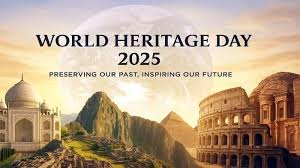World Heritage Day 2025:

World Heritage Day 2025, themed “Heritage under Threat from Disasters and Conflicts: Preparedness and Learning from 60 years of ICOMOS Actions,” is being celebrated globally, reaffirming the need to protect cultural and natural legacies.
- Heritage Sites are locations officially recognized by UNESCO for possessing outstanding cultural, natural, or mixed universal value.
- They represent humanity’s shared legacy, preserving achievements in history, architecture, biodiversity, and culture for future generations.
- As of 2024, India proudly holds 43 UNESCO World Heritage Sites, showcasing its rich and diverse civilizational history.
India’s journey began in 1983 with the listing of Agra Fort, Taj Mahal, Ajanta Caves, and Ellora Caves as the first recognized sites. - Categories of Sites in India: Cultural Sites (e.g., Taj Mahal, Hampi): Reflecting India’s monumental architecture, spirituality, and artistic excellence. Natural Sites (e.g., Western Ghats, Sundarbans): Celebrating India’s ecological richness and biodiversity. Mixed Sites (e.g., Khangchendzonga National Park): Having both cultural and natural significance.




